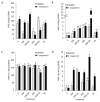The Effect of Endophytic Bacteria Bacillus subtilis and Salicylic Acid on Some Resistance and Quality Traits of Stored Solanum tuberosum L. Tubers Infected with Fusarium Dry Rot
- PMID: 32545338
- PMCID: PMC7356507
- DOI: 10.3390/plants9060738
The Effect of Endophytic Bacteria Bacillus subtilis and Salicylic Acid on Some Resistance and Quality Traits of Stored Solanum tuberosum L. Tubers Infected with Fusarium Dry Rot
Abstract
The effect of endophytic Bacillus subtilis (strains 10-4, 26D) and their compositions withsalicylic acid (SA) on some resistance and quality traits of stored potatoes infected with Fusariumdry rot were studied. The experiments were carried out on hydroponically grown Solanumtuberosum L. tubers that were infected before storage with Fusarium oxysporum and coated with B.subtilis 10-4, 26D with and without exogenous SA, and then stored for six months. It has been shownthat 10-4, 26D, 10-4 + SA, and 26D + SA reduced in different levels (up to 30-50%) the incidence ofF. oxysporum-caused dry rot (with the highest effect for 10-4 + SA). SA notably enhanced the positiveeffect of 10-4, while for 26D, such an effect was not observed. All of the tested treatments increasedamylase (AMY) and AMY inhibitors activity in infected tubers, while decreased Fusarium-inducedprotease activity (except in the case of 10-4 + SA, which promoted a slight increase) was revealed.10-4, 26D, and their compositions with SA decreased (in different degrees) the pathogen-causedlipid peroxidation, proline, and reducing sugars accumulation in potatoes after long-term storage.It was also discovered 10-4 and 26D, regardless of SA presence, decrease pathogen-inducedglycoalkaloids α-Solanine and α-Chaconine accumulation and preserved increased levels of starchand total dry matter in infected stored potatoes. The findings indicate endophytic B. subtilis and itscompositions with SA is a promising eco-friendly and bio-safe approach to cope with postharvestdecays of potato during long-term storage; however, when developing preparations-compositionsit should take into account the strain-dependent manner of B. subtilis action together with SA.
Keywords: Fusarium oxysporum; endophytic Bacillus subtilis; glycoalkaloids; hydrolytic enzymes; potatoes; quality; resistance; salicylic acid; storage.
Conflict of interest statement
The authors declare no conflict of interest. The funders had no role in the design of the study; in the collection, analyses, or interpretation of data; in the writing of the manuscript, or in the decision to publish the results.
Figures







References
-
- FAO (Food and Agriculture Organization of the United Nations) FAOSTAT—Food and Agriculture Organization of the United Nations Statistics Division. [(accessed on 31 March 2020)];2015 Available online: http://faostat3.fao.org/browse/FB/CC/E.
-
- Du M., Ren X., Sun Q., Wang Y., Zhang R. Characterization of Fusarium spp. causing potato dry rot in China and susceptibility evaluation of Chinese potato germplasm to the pathogen. Potato Res. 2012;55:175–184. doi: 10.1007/s11540-012-9217-6. - DOI
-
- Secor G.A., Salas B. Fusarium dry rot and Fusarium wilt. In: Stevenson W.R., Loria R., Franc G.D., Weingartner D.P., editors. Compendium of Potato Disease. APS Press; St. Paul, MN, USA: 2001. pp. 23–25.
-
- Wharton P., Kirk W. Fusarium Dry Rot. [(accessed on 31 March 2020)];2007 Available online: https://www.canr.msu.edu/uploads/files/fusarium-dry-rot-bulletin.pdf.
Grants and funding
LinkOut - more resources
Full Text Sources

